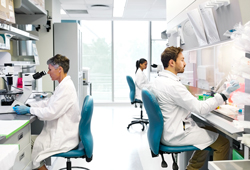Key Takeaways from Goodwin + KPMG @ JPMorgan Symposium: Mergers and Acquisitions
 On Wednesday, January 15, 2020, during the J.P. Morgan Healthcare conference, Goodwin and KPMG held their initial all-day Symposium at the St. Regis hotel in San Francisco. The Symposium was composed of five separate “bursts” entitled (i) New Frontiers in Digital Diagnostics and MedTech, (ii) Europe Unleashed, (iii) Knowing the Best IPO Strategy, (iv) Trends in Biopharma and (v) Mergers and Acquisitions. Stéphane Bancel, the Chief Executive Officer of Moderna Therapeutics, provided the keynote address.
On Wednesday, January 15, 2020, during the J.P. Morgan Healthcare conference, Goodwin and KPMG held their initial all-day Symposium at the St. Regis hotel in San Francisco. The Symposium was composed of five separate “bursts” entitled (i) New Frontiers in Digital Diagnostics and MedTech, (ii) Europe Unleashed, (iii) Knowing the Best IPO Strategy, (iv) Trends in Biopharma and (v) Mergers and Acquisitions. Stéphane Bancel, the Chief Executive Officer of Moderna Therapeutics, provided the keynote address.
Burst Five consisted of a panel entitled “The Brave New World of Antitrust in Life Sciences M&A.” This panel was moderated by Stuart Cable of Goodwin and consisted of Lisa Haddad and Andrea Murino of Goodwin. In this panel, participants provided their insights regarding recent antitrust activity in the life sciences M&A sector. Overall antitrust merger investigations are up under the Trump administration, with a total of 29 investigations in 2019. In addition, the average duration of significant investigations continues to increase, with an average of 12.6 months for the first three quarters of 2019 as compared to 9.8 months for the same period in 2018. Foreign regulatory authorities also continue to increase their focus on proposed mergers, including through working collaboratively with U.S. agencies. Antitrust concerns with respect to life science transactions, especially in hot pharma markets, such as gene therapy, are high.
Key takeaways from Burst Five were as follows:
- Stay apprised of the state of antitrust merger review, as new developments may make a given transaction more risky than expected. Antitrust merger review is constantly changing, particularly as administrations change. Recent FTC decisions in life sciences M&A transactions suggest that the FTC has started to look at the entirety of a company’s product pipeline (including drugs in development as well as approved drugs) to determine if a given transaction raises anti-trust concerns. For example, as a condition to the BMS/Celgene merger, BMS was required to divest Otzela, a product for the treatment of psoriasis, marketed by Celgene. The FTC argued that this divestiture was required to incentivize BMS to continue to develop its own product candidate for the treatment of psoriasis. This was the case even though there is guarantee that BMS’s developmental product would ever be successfully developed or reach the market.
- Seek guidance from experienced antitrust counsel early in the process to evaluate regulatory risks associated with a proposed transaction and to develop an antitrust filing strategy. Given the regular changes in antitrust law, it is important to seek the counsel of experienced antitrust counsel early-on in the M&A process. Experienced counsel can help companies assess the risk profile of a given transaction and help you develop a comprehensive antitrust filing strategy. The risk profile of a given M&A transaction will also inform the provisions to be included in the Merger Agreement and other transaction documents.
- Given increased antitrust review timelines, make sure Merger Agreement contains proper protections for the seller. Given that antitrust review times have been increasing, it is important that Merger Agreements for transactions that are likely to be subject to extensive antitrust review contain the proper protections to avoid having the buyer just walk away from the seller. For example, sellers should consider strong covenants regarding the efforts that must be taken to obtain regulatory approval, an end date that allows for extension if there is a regulatory delay, and reverse termination fee payable to the seller if the buyer wants out of the agreement.
 On Wednesday, January 15, 2020, during the J.P. Morgan Healthcare conference, Goodwin and KPMG held their initial all-day Symposium at the St. Regis hotel in San Francisco. The Symposium was composed of five separate “bursts” entitled (i) New Frontiers in Digital Diagnostics and MedTech, (ii) Europe Unleashed, (iii) Knowing the Best IPO Strategy, (iv) Trends in Biopharma and (v) Mergers and Acquisitions. Stéphane Bancel, the Chief Executive Officer of Moderna Therapeutics, provided the keynote address.
On Wednesday, January 15, 2020, during the J.P. Morgan Healthcare conference, Goodwin and KPMG held their initial all-day Symposium at the St. Regis hotel in San Francisco. The Symposium was composed of five separate “bursts” entitled (i) New Frontiers in Digital Diagnostics and MedTech, (ii) Europe Unleashed, (iii) Knowing the Best IPO Strategy, (iv) Trends in Biopharma and (v) Mergers and Acquisitions. Stéphane Bancel, the Chief Executive Officer of Moderna Therapeutics, provided the keynote address.